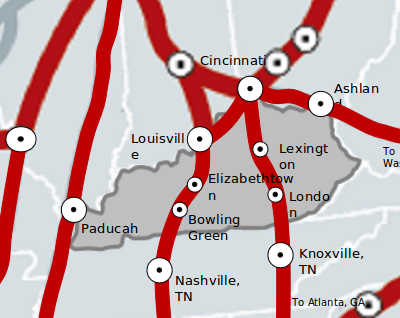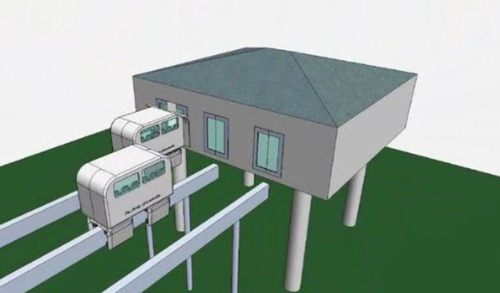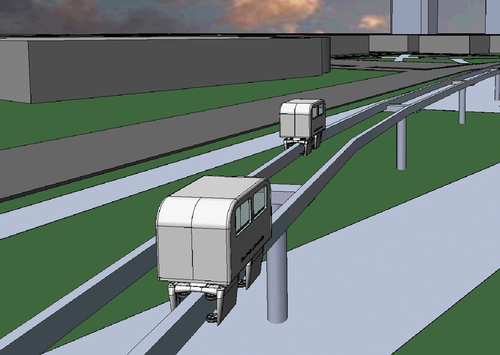[ Editor’s Note: This post originally appeared on the Coalition for the Advancement of Regional Transportation (CART)’s web site on two articles dated December 4 and 5 (here and here). Neither CART nor Broken Sidewalk offers any endorsement by printing the contents of the plan here. Thanks to guest contributor David Morse for allowing it to be reprinted. ]
The Mongiardo Plan for Statewide Passenger Rail
Yesterday (Thursday, December 3, 2009), Dr. Daniel Mongiardo gave a presentation to the CART membership calling for a massive investment in public transportation both statewide and locally. The first half of the article deals with the statewide element.
The proposal is to restore passenger rail to Kentucky’s cities and towns. Rail put most of these places on the map, and putting it back again provides many benefits.
 Red routes on the map to the left are proposed passenger rail lines. Every mid-sized city in Kentucky that lies on existing track would be served by at least one passenger rail line. The ‘Golden Triangle’ of Louisville-Lexington-Cincinnati would return to its historical role as the hub of passenger rail in the tri-state area.
Red routes on the map to the left are proposed passenger rail lines. Every mid-sized city in Kentucky that lies on existing track would be served by at least one passenger rail line. The ‘Golden Triangle’ of Louisville-Lexington-Cincinnati would return to its historical role as the hub of passenger rail in the tri-state area.
A further goal would be to link into the High Speed Rail network currently being planned, and prominently features several 110mph links. Chicago-Indy-Louisville-Nashville is one, as is Cinci-Lexington-London-Knoxville. Cleveland-Columbus-Cincinnati-Louisville would provide access to Ohio along their “3C” corridor.
Taken together, implementing this plan would greatly decrease the travel times between cities, and greatly increase the average Kentuckian’s mobility.
The Mongiardo Plan for Louisville – Phase 1
Thursday, Dr. Daniel Mongiardo gave a presentation to the CART membership calling for a massive investment in public transportation both statewide and locally. This half of the article deals with the first phase of the local plan, specifically, the construction of rapid access monorail (RAM) serving Louisville.
RAM cars are about the size of a van, with a seated capacity of 12 people, or a standing capacity of about 30 people. From a user’s perspective, riding RAM is about like an elevator—you step in, after some seconds the doors close, and you’re on your way. Peak speed is in excess of 50mph. The RAM sits atop a lean rail on a concrete pylon. The pylon is fairly compact, maybe a large telephone pole.
The proposed route covers the usual north-south axis of juicy destinations for every transit project: UPS, the Airport, Fairgrounds, the John, University of Louisville, Medical Center, the new arena, and the central business district. Thereafter it turns west on Main to a new intermodal station at 15th street (more on that in Phase II), and on west to 26th street.
Its not clear to me what the stop frequency would be going through Old Louisville. Would this completely replace the need for the #2 and #4 in that corridor? Or would it serve as an express, bypassing the nabes between Hill Street and Broadway, but connecting the University of Louisville to the Medical Center in a 5:00 stop-light-free hop? Note that it takes more than five minutes to park a car in the medical center, not even counting driving there!
Extensions would provide building-by-building access to the medical center, indeed that’s likely where construction would begin.
My impression is that autonomous vehicles spend their entire day shuttling between two stations. Stations connect one or more lines, and have an elevator to the ground level. When you debark from a RAM car and have to choose between branches, you simply walk to the side of the station with access to that destination, and walk through the door into the waiting RAM car.
Since the proposed alignment was so similar to the T2 Light Rail project from 2002, the question arose, what are the strengths and weaknesses of each?
| waiting | operating subsidy per boarding* | fuel | safety | right of way negotiations | technologyrisk | |
|---|---|---|---|---|---|---|
| Bus | 12 minutes | $5 | diesel | excellent | n/a | proven here |
| T2 Light Rail | 15 minutes | $2 | electric | excellent | tricky | proven elsewhere |
| R.A.Monorail | 20 seconds | -$1profit! | electric | probablyexcellent | lesstricky | unproven |
* = operating subsidies are speculative, esp. on the RAM, but TARC gets about 15% of their income from farebox with buses. (I’m not sure if that includes fantastically more expensive paratransit in the denominator). Light rail farebox recovery rates are in the 25 to 60 percent range—it depends heavily on if you have exclusive right-of-way—I think there’s a system in Canada that may actually be breaking even. R.A. Monorail promises a much lower cost per boarding, largely because there is no engineer on board. Operating costs could be on the order of 20 cents per boarding, and with the significantly higher level of service, this would translate to both massively increased demand and an operating profit at TARC’s current fare schedule. Holy Underwear, Batman!
Some might argue that the RAM would lose jobs compared to buses, because its so much less labor intensive. I think this is backwards. We have the $60m / year from the occupational tax, and that’s not going away anytime soon. Our bus system has been slowly withering for a long time, losing the middle class riders. Having a major line that makes a profit – or at least breaks even – will I think result in those operators getting put onto routes further out in the system. Furthermore, those routes become more attractive with a big continuous timed-transfer at map seam down the center of the city. Ridership will naturally increase system wide. That will in turn spur demand for more transit, and thus more work for our friends at ATU Local 1447. Transit needs a break right now. These schedule cuts have got to stop. We need to get the middle class back on board.
On paper, the RAM system is vastly superior to any alternative. The level of service seems reminiscent of the heavy rail subway systems in places like New York and London in peak hours, without the crush of bodies or sky-high fares. The only issue is that nobody’s build the darned thing yet, and its a big gamble to go first.
Any investment in an advanced transit line like this one would involve federal dollars and therefore a formal alternatives analysis like the one above – but done at a much more professional level. If RAM can get into that study, and back up its claims, it seems like there’s a good chance the system would get built and become an international success. If it can’t there’s every reason to believe that we would buy the best technology available, perhaps the T2 Light Rail project or Bus Rapid Transit.
RAM would make a very strong connection for the dense urban core of Louisville. In the Phase 2 article we’ll talk about the plans for linking up the suburbs.





There’s a reason why this hasn’t been done somewhere else. Honestly, this whole monorail thing reminds me of the monorail system that failed in that one simpson’s episode. IMAO, I feel that the best thing for Louisville is LRT. The entire city was once covered with these tracks, why not slowly build everything back to that.
The transcription from CART missed an important map: http://cartky.org/sites/default/files/mongiardo-rail-map-ky.png , without which it looks like the plan is all High Speed Rail with no intrastate passenger rail.
Whoops, nevermind.
Actually, this type of transportation has been in operation for over 30 years in Morgantown, WV – the WVU Personal Rapid Transit (or PRT) system. While there are technological differences (the PRT system operates using tires on a concrete track), the concept of point-to-point destination selection for a low fare is the same. And without this system, Morgantown would have been choked to death by buses and cars shuttling students between the two campusus long ago. This idea is worthy of serious consideration.
Not a big fan of superimposed systems. There is tempation to ignore the dynamics below, much like an interstate. And don’t forget the shadows. Here is an interesting (partial) take from back in the day, when this was a new idea: http://books.google.com/books?id=AzrmwPiBvgcC&pg=RA1-PA141&lpg=RA1-PA141&dq=Norman+Krumholz+Downtown+people+mover&source=bl&ots=bezMPcSUZK&sig=eY4A1HIEmp1tSqFPtIbV3WJ2pSo&hl=en&ei=sWcdS_-lJ4HRlAfphsjyCQ&sa=X&oi=book_result&ct=result&resnum=1&ved=0CAwQ6AEwAA#v=onepage&q=Norman%20Krumholz%20Downtown%20people%20mover&f=false